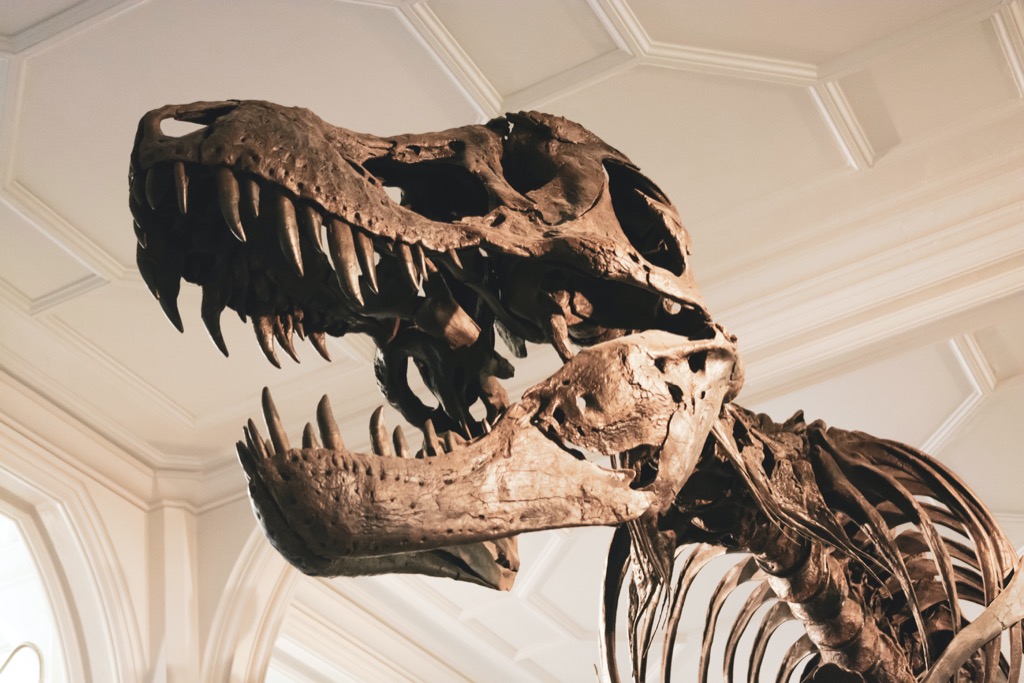The iconic scene in the thrilling blockbuster, Jurassic Park, where a thunderous T-Rex attacks a jeep during a raging storm, has captivated audiences for years. Dr. Alan Grant’s famous warning, “Don’t move!” led many to believe that the colossal dinosaur wouldn’t detect you if you remained motionless. However, the truth may surprise you. (And the astonishing facts about Velociraptors might be even more intriguing!) Contrary to popular belief, substantial evidence suggests that the Tyrannosaurus Rex boasted exceptional eyesight, potentially surpassing that of today’s hawks and eagles. Its ability to discern both stationary and moving objects was vital for navigating its surroundings and avoiding obstacles.
The Fascination With This “Fact” Spurred a Wave of Research
In 1993, DinoMorph was established by Kent Stevens, a distinguished professor from the University of Oregon, with a vision to create simplified yet scientifically accurate digital models of dinosaur skeletons. Collaborating with renowned paleoartist Garfield Minott at the Royal Ontario Museum, Stevens meticulously sculpted lifelike renditions of various theropod species, including the infamous Tyrannosaurus Rex.
Through comprehensive experiments involving laser pointers, glass plates, and taxidermic glass eyeballs, Stevens delved into the visual capabilities, depth perception, and binocular range of these dinosaurs. His 2006 findings from the “inverse perimetry” experiments unveiled that a T-Rex boasted a remarkable binocular range of 55 degrees, surpassing that of many raptorial birds.
The structural evolution of the T. rex’s skull and eyes, characterized by elongated snouts, drooping cheekbones, and enlarged eyes, further solidified the crucial role of sight in the species’ survival.
To gauge the extent of its visual acuity, Stevens transplanted optical systems from distant relatives of the T-Rex, including eagles, chickens, and crocodiles, into the T-Rex’s larger eyeball. His research suggested that the T-Rex’s vision might have been up to 13 times sharper than that of a modern human, though these findings were considered best-case scenarios. In comparison, an eagle’s vision is roughly 3.6 times as sharp as a human’s. Additionally, it was revealed that the T-Rex could maintain visual clarity of objects up to 6 kilometers away, while human vision remains clear at only about 1.6 kilometers. Stevens affirmed, “With the size of its eyeballs, the T-Rex couldn’t help but have excellent vision.”
The film adaptation, along with the book, emphasized the need for additional DNA to bridge the gaps in resurrecting these ancient creatures. While the film used frog DNA as a storytelling device, the book incorporated DNA from various sources, including birds and lizards. This led to speculation about the dinosaurs’ resemblance to frogs, sparking the thought that Dr. Grant’s statement might have been more about a frog’s vision than that of a T-Rex.
The African reed frog, a prevalent species in West Africa known for its horizontal pupils, possesses vision akin to other frogs but cannot see in the red spectrum. While frogs might struggle to detect stationary prey, they can still sense subtle movements. Kent Stevens dispelled the notion, stating, “If you’re sweating in fear one inch from the nostrils of the T. Rex, it would figure out you were there anyway.”
Apart from its exceptional vision, the T-Rex relied on a heightened sense of smell and decent hearing. Its robust olfactory system, comparable to that of modern vultures, enabled it to detect decaying matter from considerable distances, facilitating both scavenging and hunting. Nonetheless, debates persist regarding the T-Rex’s maximum speed, with many scientists concurring that it likely ranged between 17 to 25 mph. Imagining the jeep chase scenario at such speeds undoubtedly adds to the thrilling tension of the scene.
Enhancing Your Knowledge: T-Rex Vision
In addition to its formidable size and strength, the T-Rex possessed exceptional vision, potentially surpassing that of modern predatory birds like hawks and eagles. This keen eyesight allowed it to discern both stationary and moving objects, ensuring it could effectively navigate its surroundings and locate potential prey.
Understanding T-Rex Anatomy
Despite its massive stature, the T-Rex’s arms were relatively small, measuring around 1 meter in length. However, owing to the substantial regions for muscle attachment on the bones, these seemingly diminutive arms were believed to have been capable of lifting over 400 pounds. Understanding this aspect of the T-Rex’s anatomy sheds light on its unique physical capabilities.
The Fascinating Link Between T-Rex and Chickens
Interestingly, chickens, which were initially domesticated not for consumption but for cockfighting, are considered to be the closest living relatives of the mighty T-Rex. Unveiling this evolutionary link between these seemingly disparate creatures provides a fascinating insight into the biological history and lineage of these formidable predators.
Unveiling T-Rex’s Adaptations
Examining the structural adaptations of the T-Rex’s skull and eyes, characterized by elongated snouts, drooping cheekbones, and enlarged eyes, provides valuable insights into the species’ evolutionary journey. These physical features underscore the vital role of sight in the T-Rex’s survival and hunting prowess, offering a deeper understanding of its unique adaptations over time.
Unveiling the T-Rex’s Auditory Prowess
While the article extensively discusses the T-Rex’s remarkable visual capabilities, it’s equally crucial to explore the dinosaur’s auditory skills. Recent research suggests that the T-Rex likely possessed acute hearing, enabling it to detect subtle sounds over considerable distances. Understanding the interplay between its heightened visual and auditory senses provides a comprehensive view of how this apex predator navigated its ancient environment and interacted with its surroundings.
Behavioral Patterns of the T-Rex
Delving deeper into the T-Rex’s behavioral patterns unveils intriguing insights into its social dynamics and potential interaction with its species. Recent paleontological studies have hinted at possible pack behaviors among certain dinosaur species, including the T-Rex. Exploring the implications of such social structures contributes to a more comprehensive understanding of the T-Rex’s lifestyle and the intricate dynamics of its prehistoric ecosystem.
Scavenger or Predator?
Contrary to popular belief, recent discoveries challenge the conventional notion of the T-Rex solely as a ferocious predator. Emerging evidence suggests that it might have also been a proficient scavenger, relying on its powerful olfactory senses to detect decaying matter over vast distances. Analyzing the T-Rex’s feeding habits from a scavenging perspective sheds new light on its ecological role and feeding behaviors, providing a more nuanced portrayal of this iconic dinosaur’s place in the ancient food chain.
Environmental Adaptations of the T-Rex
Examining the T-Rex’s physical adaptations within the context of its prehistoric environment yields valuable insights into its evolutionary journey. By understanding how the T-Rex adapted to various environmental challenges, such as changes in climate, landscape, and available prey, researchers can paint a more comprehensive picture of the complex ecological interplay that shaped this apex predator’s evolution and survival over millions of years.
Global Distribution and Paleontological Significance
Exploring the global distribution of T-Rex fossils and their significance in the field of paleontology unveils the broader impact of these discoveries on our understanding of Earth’s ancient history. Investigating the geographical spread of T-Rex remains across different continents provides valuable clues about past land formations and the migration patterns of these awe-inspiring creatures. Furthermore, analyzing the paleontological significance of these findings contributes to our collective knowledge of the T-Rex’s role in the broader context of prehistoric biodiversity and evolution.
Fun FAQs That You Might Be Asking
How Did the T-Rex Hunt for Prey?
While the T-Rex is commonly portrayed as a fearsome predator, it’s important to recognize that it might have also relied on scavenging as a means of sustenance. Understanding the T-Rex’s potential dual feeding habits can provide valuable insights into its hunting behavior. Keep in mind that its acute sense of smell and ability to detect decaying matter could have influenced its hunting strategies, impacting your understanding of its role in the prehistoric ecosystem.
What Can Fossil Discoveries Tell You?
Fossil discoveries play a crucial role in unraveling the mysteries surrounding the T-Rex’s evolutionary journey. Studying these ancient remains can provide a deeper understanding of the T-Rex’s physical adaptations and its interactions with its environment over millions of years. By exploring the significance of these fossils, you can gain valuable insights into the T-Rex’s place in the larger context of prehistoric biodiversity and global ecosystems.
Did T-Rexes Communicate with Each Other?
While concrete evidence of T-Rex communication remains limited, researchers speculate that these mighty creatures might have had complex social behaviors. Although their exact communication methods are yet to be fully deciphered, studying their potential interactions with each other can offer valuable clues about their social dynamics and group behaviors. Recognizing the possibility of T-Rex socialization contributes to a more comprehensive understanding of their place in the ancient ecosystem.
How Does Scientific Exploration Shape Understanding?
Advancements in scientific research continually shape our understanding of the T-Rex and its prehistoric world. By staying updated with the latest discoveries and paleontological insights, you can gain a deeper appreciation for the complexities of the T-Rex’s evolutionary journey. Acknowledging the dynamic nature of scientific exploration fosters a more comprehensive and accurate perception of this iconic dinosaur and its role in Earth’s ancient history.




